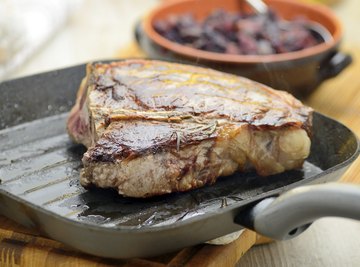
When you feel heat, you are essentially sensing the transfer of thermal energy from something hot to something colder, your body. When you feel something cold, you are sensing the transfer of thermal energy in the other direction: out of your body into something colder. This type of heat transfer is called conduction. The other main type of heat transfer that occurs on Earth is between fluids and is known as convection.
Calculating Heat Transfer by Conduction
Start by entering the known variables into the fairly simple equation used to determine the rate of heat transfer, q, between two mediums by conduction: q = (kA(Thot–Tcold))/d. For example, if k = 50 watts/meter Celsius, A = 10 meters^2, Thot = 100 degrees Celsius, Tcold = 50 degrees Celsius, and d = 2 meters, then q = (50*10(100–50))/2.
Next subtract the two temperatures to work through that part of the equation and get the temperature difference. In this example, the calculation would be 100 degrees Celsius – 50 degrees Celsius = 50 degrees Celsius, resulting in the simplified equation q = (50*10(50))/2.
Multiply the thermal conductivity and the surface area. So now the simplified equation is q = (500*50)/2.
Multiply the product of the thermal conductivity and surface area you found in the previous step by the temperature difference to obtain q = 25,000/2.
Finally, divide the product calculated in the previous step by the thickness to obtain q = 12,500 W.
Calculating Heat Transfer by Convection
- For both conduction and convection:
- Thermal conductivity (k), the innate thermal conductivity of the material or fluid being heated or cooled.
- Area (A), defined as the cross-sectional area through which the heat is being transferred.
- For conduction only:
- Conduction temperature gradient (Thot–Tcold), defined as the temperature difference in the direction of energy flow from the hot region to the cold region.
- Thickness (d), meaning the thickness, or length, of the conductor.
- For convection only:
- Convection temperature (Tsurface–Tfluid), defined as the difference between the surface temperature of the fluid taking in energy and the fluid temperature.
The other primary method of heat transfer is called radiation, and this is how heat is transferred from the sun to Earth in the vacuum of space. The equation for this kind of heat transfer is q = emissivity_Stefan's constant_radiating area(temperature of radiator^4–temperature of surroundings^4).
Start by entering the known variables into a similar equation to calculate heat transfer by convection: R = kA(Tsurface–Tfluid). For example, if k = 50 watts/meters Celsius, A = 10 meters^2, Tsurface = 100 degrees Celsius, and Tfluid = 50 degrees Celsius, then your equation can be written as q = 50*10(100–50).
Calculate the temperature difference. In this example, the calculation would be 100 degrees Celsius – 50 degrees Celsius = 50 degrees Celsius, resulting in q = 50*10(50).
Next, multiply the thermal conductivity by the surface area to obtain q = 500(50).
Finally, multiply this product by the temperature difference, leaving the rate of energy transfer expressed in watts. In this example, q = 25,000 W.
Things You'll Need
Tips
References
Tips
- The other primary method of heat transfer is called radiation, and this is how heat is transferred from the sun to Earth in the vacuum of space. The equation for this kind of heat transfer is q = emissivity*Stefan's constant*radiating area(temperature of radiator^4–temperature of surroundings^4).
About the Author
Brett Smith is a science journalist based in Buffalo, N.Y. A graduate of the State University of New York - Buffalo, he has more than seven years of experience working in a professional laboratory setting.
Photo Credits
valeriopardi/iStock/Getty Images
